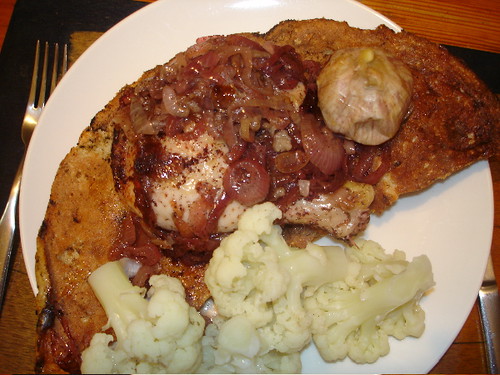
My husband and I both love good Chinese food and since it is impossible to find good Chinese food in Israel, we have to wait until we go to London or the States. However, I did learn to make Chinese food from my grandparent’s Chinese cook, Ying. She is a master in the kitchen and was a great teacher. She really understands the science behind cooking, whether she is explaining how to cook various types of meats and poultry or baking. She also taught me a lot about the balance of flavours and how important that is in Chinese cooking. One flavour should not necessarily stand out more than the other; it should be a marriage of ingredients. I had so much fun learning from her. We even took a French pastry course together. She was raised in Vietnam, so she already knew quite a bit about French cooking, but she enjoyed the course, just the same.
My husband was away for his birthday and we celebrated it when he came back. I made him one of our favourites, Szechuan Chicken with Cashews. The heat from the chili paste and the crunch from the cashews make this dish. This dish is spicy, so if you can’t stand the heat, you might want to use one teaspoon of chili paste instead of two. If you like very spicy Thai or Indian food, like we do, you could add another half a teaspoon. I served this over Thai rice.
This recipe looks like it has a lot of steps, but it is very easy to make.
- 600 g boneless skinless, chicken thighs or breasts, cut into 2cm (3/4-inch) pieces
- 1 egg white
- 1 teaspoon cornstarch
- 1 teaspoon dark soy sauce
- Pinch of black pepper
- 1 large yellow or red bell pepper
- 1 medium yellow onion
- 1 head of broccoli separated into florets
- 1 tablespoon cornstarch
- 1 tablespoon cold water
- 1 tablespoon light soy sauce
- 2 tablespoons peanut or canola oil
- 1 cup raw cashew nuts
- 1/4 teaspoon of salt
- 2 tablespoons peanut or canola oil
- 2 teaspoons finely chopped ginger root
- 1 tablespoon hoisin sauce
- 2 teaspoons chili paste
- 1/2 cup chicken broth
- 2 tablespoons chopped green onion
-
Mix the egg white, 1 teaspoon of cornstarch, 1 teaspoon of dark soy sauce and the black pepper in a medium bowl; stir in the chicken. Cover and place in the refrigerator for 20 minutes.
-
Meanwhile, cut the bell pepper into 2cm (3/4-inch) pieces. Cut the onion into 16 pieces and cut the broccoli in to small florets.
-
Combine the 1 tablespoon cornstarch, water and 1 tablespoon light soy sauce in a small bowl.
-
Heat the wok on high, and when it is very hot, add the 2 tablespoons of peanut oil; tilting the wok to coat the sides. Add the cashews and stir-fry them for about one minute or until lightly browned. Remove the cashews from the wok and drain them on a paper towel. Sprinkle them with salt.
-
Note: You can use roasted cashews, but obviously do not salt them and only add them at the last minute.
-
Add the chicken to the wok and stir-fry until the chicken turns a pale colour. Remove the chicken from the wok and set aside in a bowl or on a plate.
-
Add 2 tablespoons of peanut oil. Add the onion and ginger, and stir-fry until the ginger is light brown and the onion is translucent. Add the chicken, bell pepper, broccoli, hoisin sauce, cashews (if using roasted ones) and chili paste, and stir-fry for 1 minute. Add the broth and heat until boiling. Stir in the cornstarch mixture and stir for about 1 minute until the sauce is thickened. Stir in the cashews (if using raw ones) and green onions.























































